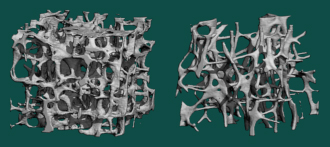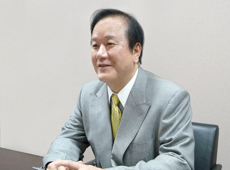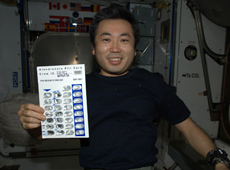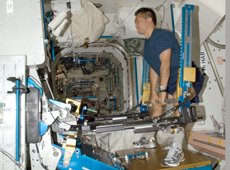Q. What kind of clinical work and research do you do?
I am a physician specializing in endocrinology and metabolism. These fields focus on the diagnosis and treatment of disorders caused by abnormalities in the production or action of various hormones, including pituitary hormones, thyroid hormone, steroid hormones, parathyroid hormone and gastrointestinal hormones. I also take care of patients with metabolic disorders, including diabetes mellitus, hyperuricemia and metabolic bone diseases. Among them, my specialty is metabolic bone diseases.
Q. Tell us about the space medicine experiment you are engaged in.

Micro CT images of the spines of a healthy 23-year-old woman (left) and an 85-year-old woman with osteoporosis. The bone trabeculae structure of the 85-year-old woman is deteriorated and the bone mass is reduced. (Courtesy of Dr. Masako Ito, Department of Radiation, Nagasaki University Hospital)
As a joint research project between the United States and Japan, we've been trying to see if we could prevent the loss of bone mass and formation of kidney stones during long stays in space by using a bisphosphonate formula used in the treatment of osteoporosis. During his mission on the International Space Station, astronaut Koichi Wakata took part in this experiment as a human subject. He took bisphosphonate regularly during his mission on the ISS, and we measured his bone mass before and after the flight.
Bones maintain their strength and structure through a metabolic process where bone cells are continually destroyed (bone resorption) and created (bone formation). When the balance between bone cell resorption and formation breaks down, bone mass declines and bone structure changes, reducing the strength of the bone to a fragile state. To be more specific, normally, old, deteriorated bone cells get micro-fractures that are similar to metal fatigue. These cells are then dissolved and destroyed by cells called osteoclastic cells. Then, the body issues an order to "re-create" these cells, and the bones are rebuilt by osteoblast cells. We don't completely understand how and why that order is issued, but it is thought that the mechanical stress placed on the bones by gravity and activity plays an important role in maintaining a proper balance of bone metabolism. Body parts on which a greater burden is placed through exercise are stronger and have more bone mass.
Conversely,in the microgravity environment of space, bone metabolism becomes unbalanced and bone mass is reduced very rapidly. When we measured the bone density of astronauts who stayed in space for a long period, the results showed that femur density was reduced on average by 1.0% to 1.5% a month. This is a drastic reduction - this level of loss normally takes more than a year in a patient with osteoporosis. At the same time, when bone mass is reduced, calcium dissolved from bones into urine can cause urinary lithiasis, or kidney stones. Astronauts on the space station exercise for two hours a day, but to provoke bone formation, strong instantaneous impact is needed. Thus, even a wide range of exercises in zero gravity cannot prevent the rapid loss of bone mass.
So I suggested that bisphosphonates, a class of drugs used to treat osteoporosis because of its effectiveness in preventing bone resorption, may be effective in space as well. Osteoporosis usually develops with aging or after menopause due to the reduction of sex hormones, so the mechanism of osteoporosis caused by zero-gravity conditions is somewhat different. However, because of the decreased kinetic load, bone resorption becomes significantly worse, and insufficient bone formation takes place. Thus, I was confident that using a bisphosphonate would prevent the loss of bone mass and urinary lithiasis in space. This space medicine experiment is extremely important, not only for long stays on the space station, but also for keeping astronauts healthy on much longer space missions in the future, such as a flight to Mars. In addition, this experiment could greatly improve the treatment of osteoporosis in bedridden patients, whose kinetic load is decreased just like that in a zero-gravity environment.
Q. This research is a Japan-U.S. collaboration. How do you work with NASA?

We proposed a research program as a JAXA team to examine the effect of a pre-flight single dose intravenous bisphosphonate injection on bone loss and renal stone formation induced by microgravity in the space. NASA made a similar research proposal on the effect of weekly oral administration of a bisphosphonate on bone loss during the space flight. Ultimately we agreed to use NASA's choice of drug, but astronauts from JAXA can have a choice to take the intravenous bisphosphonate as well. NASA and JAXA will share all the results, but NASA will mainly analyze the research results on the loss of bone mass, while JAXA will be responsible for analyzing data on urinary lithiasis.
The once weekly oral bisphosphonate that NASA suggested is called alendronate. The one we proposed was a powerful bisphosphonate called zoledronic acid, which inhibits bone resorption by an intravenous dose once a year. At first, we were going to compare the effectiveness of these two formulas, but the problem was that the formula we proposed hadn't been approved for osteoporosis treatment in both our countries. This drug showed a very powerful effect against osteoporosis even when injected only once a year, but at that time the injections were permitted only for cancer patients with bone metastasis. In these cancer cases, there were often many infectious complications such as periodontal diseases, especially pyorrhea. A problem later emerged for those patients with some cases of jaw osteonecrosis, in which jaw bones die after the use of zoledronate. Because of that, when it came to use of the drug by astronauts, concerns surfaced over such complications. As a result, we decided to use the oral agent proposed by NASA.
We are planning to analyze the data together. Bone mass data for astronaut Wakata immediately after his return was quite good, but the number of human subjects is still very limited and individuals can be easily identified, so we cannot publish the results yet. We will continue the collaborative project with NASA, and once we have collected data from several subjects, we would like to publish the results. I'm looking forward to seeing what results we get.
Q. What is the hardest part of carrying out this experiment?

Astronaut Wakata holding a bisphosphonate formula (Courtesy of NASA)
This experiment is conducted in cooperation between the United States and Japan, and aside from astronaut Wakata, astronauts from NASA and Canada are also participating as human subjects. We did initially struggle to convince these individuals to participate. Flight surgeons from NASA and JAXA tried very hard to explain the experiment, but initially no one agreed. Many astronauts were concerned that their teeth would rot because of this injection drug, and thought that, even if their bone mass was reduced, they would soon recover it after their return to Earth. Even though we are very confident about the effects of bisphosphonate usage, this experiment cannot be conducted unless there are human subjects that will participate. Just as we were about to give up hope that this project could advance, astronaut Wakata stepped forward as a subject, understanding the importance of this research.
Once JAXA's physicians explained the experiment to astronaut Wakata, he accepted the task that no one else had previously agreed to do. After that, another seven or eight astronauts followed suit. Maybe they thought, "If astronaut Wakata is in, I'll join, too." In a TV interview, astronaut Wakata said something like, "I'm going to be a guinea pig," but I think he made a very brave decision.
Q. When you saw astronaut Wakata walking steadily into the press conference after his return, what did you think?

Astronaut Wakata working out (Courtesy of NASA)
Astronauts usually have some problems with their blood pressure or sense of balance, as well as muscle weakness, right after their return to Earth, but astronaut Wakata had a good sense of balance and was able to walk without trouble. Among astronauts coming back from long stays in space, there have not been many who've attended a press conference right after their return to Earth, so astronaut Wakata became a popular topic of conversation. Many people were asking me, "Was it because he was taking bisphosphonate?" but actually I think muscles are more important to walking than bones are. So, I think the reason astronaut Wakata was able to walk well was his awareness that he should not lose his muscle strength in space, rather than the effects of bisphosphonate.
